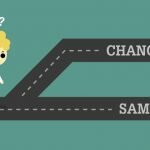When Goldilocks tasted Baby Bear’s porridge, how did she know it was just right? Papa Bear’s porridge was too hot. Mama Bear’s was too cold. If Goldilocks had tasted Baby Bear’s porridge first, she might have found that too hot or cold as well. But being third, and knowing it was in the middle of two other options, it was just right. This is the Goldilocks effect, a behavioral heuristic.
The Goldilocks effect, as described by Daniel Kahneman, says that when presented with three options, people will generally choose the one in the middle. The large will look too big, the small too small – and the medium is just right.
What does it mean for UX design?
There are obvious examples of how to use the Goldilocks effect in marketing. One example I’ve seen several times is coffee sizes. Medium is the most common, as it’s perfect compared to Small and Large.
But what about UX design? We’re not looking to sell people on things. UX practitioners want to make experiences more intuitive. That means we should look for opportunities to use the Goldilocks effect to make the best choice more easy to spot.
Take, for example, a real estate email. The person getting the email has said that they are comfortable paying $200,000 – $400,000 for a new place. Instead of showing them three places at the top of their price limit, the team could design the algorithm to show one place at the low end, one in the middle (which is what the reader wants most of all!) and one at the high end.
Or imagine an app has opportunities to help people accomplish a healthy behavior. They know people are most likely to maintain the behavior if they try it three times in a week. They can encourage people to make this choice by giving three options: try once this week, try three times, try five times.
Variations on the Goldilocks effect
There are some variations on the Goldilocks effect. For example, the Decoy effect could be considered a variation. Dan Ariely talks about the Decoy effect in terms of viewing houses. If a realtor shows two similar houses, and one very different, the viewer will almost never consider the different house. They will choose the nicer of the two similar houses, because there’s something clear to compare between the two.
When Baby Bear tasted his porridge, how did he know it was just right? Papa Bear had just announced his porridge was too hot. Mama Bear’s was too cold. If Baby Bear had tasted his porridge first, he might have found his too hot or cold as well. But being third, and knowing his was in the middle of two other options, it was just right. This is the Goldilocks effect, a behavioral heuristic.
The Goldilocks effect, as described by Daniel Kahneman, says that when presented with three options, people will generally choose the one in the middle. The large will look too big, the small too small – and the medium is just right.
What does it mean for UX design?
There are obvious examples of how to use the Goldilocks effect in marketing. One example I’ve seen several times is coffee sizes. Medium is the most common, as it’s perfect compared to Small and Large.
But what about UX design? We’re not looking to sell people on things. UX practitioners want to make experiences more intuitive. That means we should look for opportunities to use the Goldilocks effect to make the best choice more easy to spot.
Take, for example, a real estate email. The person getting the email has said that they are comfortable paying $200,000 – $400,000 for a new place. Instead of showing them three places at the top of their price limit, the team could design the algorithm to show one place at the low end, one in the middle (which is what the reader wants most of all!) and one at the high end.
Or imagine an app has opportunities to help people accomplish a healthy behavior. They know people are most likely to maintain the behavior if they try it three times in a week. They can encourage people to make this choice by giving three options: try once this week, try three times, try five times.
Variations on the Goldilocks effect
There are some variations on the Goldilocks effect. For example, the Decoy effect could be considered a variation. Dan Ariely talks about the Decoy effect in terms of viewing houses. If a realtor shows two similar houses, and one very different, the viewer will almost never consider the different house. They will choose the nicer of the two similar houses, because there’s something clear to compare between the two.
Dan Kahneman also talks about how the Goldilocks effect shifts when there are four items. People tend to choose #3 – the “middle” but the better of the two “middles”. This combines the Decoy and Goldilocks effects!
There are some variations on the Goldilocks effect. For example, the Decoy effect could be considered a variation. Dan Ariely talks about the Decoy effect in terms of viewing houses. If a realtor shows two similar houses, and one very different, the viewer will almost never consider the different house. They will choose the nicer of the two similar houses, because there’s something clear to compare between the two.
Dan Kahneman also talks about how the Goldilocks effect shifts when there are four items. People tend to choose #3 – the “middle” but the better of the two “middles”. This combines the Decoy and Goldilocks effects!
How to use it
Using the Goldilocks effect isn’t hard. Think of it as a lens through which to view UX design choices. When it’s done well, the usability tests will prove it: the designs will be intuitive!


